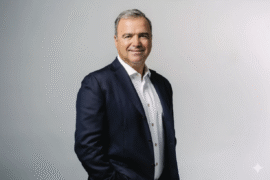This article may contain references to products or services from one or more of our advertisers or partners. We may receive compensation when you click on links to those products or services. Nonetheless, our opinions are our own.
The information presented in this article is accurate to the best of our knowledge at the time of publication. However, information is subject to change, and no guarantees are made about the continued accuracy or completeness of this content after its publication date.
- How to Save $100,000 in Three Years: A Proven Approach
- Are You Ready to Take Control of Your Finances?
- Understanding Financial Motivation
- Creating a Budget That Works
- Automating the Savings Process
- Cutting Unnecessary Expenses Without Sacrificing Joy
- Maximizing Income Through Side Hustles
- Paying Down Debt to Accelerate Savings
- Utilizing Employer-Sponsored Savings Plans
- The Importance of an Emergency Fund
- Managing and Reducing Taxes
- Setting Short-Term Goals to Stay Motivated
- Frequently Asked Questions
- Final Thoughts
- Recommended Reads
How to Save $100,000 in Three Years: A Proven Approach
Everyday life often overshadows the importance of saving money. However, achieving ambitious financial goals is possible with determination and a solid plan. Saving $100,000 in just three years may seem daunting, but it becomes an achievable milestone with the right strategies—careful budgeting, wise investments, and a commitment to cutting unnecessary expenses.
This guide breaks down the key strategies successful savers use, offering actionable steps that can be applied to any financial situation.
Are You Ready to Take Control of Your Finances?
Living paycheck to paycheck can feel exhausting. Many people dream of having a substantial savings account but often feel overwhelmed by the challenges. The good news? Financial success isn’t just for the wealthy—it’s possible for anyone with the right plan.
This journey isn’t just about putting money aside; it’s about changing habits, making intentional financial decisions, and creating a lifestyle prioritizing long-term security over short-term pleasures. Whether saving for a home, funding education or aiming for financial independence, building substantial savings is a crucial step toward those goals.
Understanding Financial Motivation
A decisive financial goal begins with a clear understanding of why saving matters. Identifying financial motivations is crucial when aiming for a significant milestone like $100,000. Consider the following:
- Dreams and Aspirations: Saving for a home, travel, early retirement, or other life-changing experiences.
- Security and Stability: Building a financial cushion to handle emergencies and unexpected expenses.
- Independence: Gaining financial freedom to make choices without the constant stress of money.
Aligning saving strategies with personal motivations creates a sense of purpose, making each dollar saved feel like an investment in the future rather than a sacrifice.
Creating a Budget That Works
A well-structured budget is the foundation of any successful savings plan. The first step is tracking income and expenses, categorizing spending into fixed and variable costs:
- Fixed Expenses: Rent, mortgage, insurance, and other necessary costs.
- Variable Expenses: Groceries, dining out, entertainment, and subscriptions.
Adjusting spending habits to prioritize savings doesn’t mean eliminating enjoyment. Instead, it involves making intentional choices about where money goes and how it supports long-term goals. Reviewing and tweaking the budget regularly ensures that financial progress remains steady.
Automating the Savings Process
Automating the process is one of the most effective ways to save consistently. Setting up automatic transfers to a savings or investment account removes the temptation to spend and ensures progress without relying on willpower. Even small, consistent contributions add up over time, transforming saving from a burden into a seamless habit.
Cutting Unnecessary Expenses Without Sacrificing Joy
Saving money doesn’t mean eliminating enjoyment. Minor adjustments can lead to significant savings without feeling deprived:
- Dining Out Strategically: Instead of eliminating restaurant visits, reserve them for special occasions and focus on home-cooked meals.
- Subscription Services: Review current subscriptions and cancel those that provide little value.
- Explore local events, parks, and community gatherings for affordable entertainment options.
| Expense Category | Current Monthly Cost | Proposed Monthly Cost | Monthly Savings |
|---|---|---|---|
| Dining Out | $200 | $100 | $100 |
| Subscriptions | $80 | $30 | $50 |
| Entertainment | $150 | $50 | $100 |
These small but powerful changes allow for continued enjoyment while steadily progressing toward financial independence.
Maximizing Income Through Side Hustles
Increasing income can significantly speed up savings. A side hustle provides extra cash flow without requiring drastic lifestyle changes. Options include:
- Freelancing: Leveraging skills in writing, graphic design, or programming.
- E-commerce: Selling handmade goods, printables, or drop shipping.
- Gig Economy Jobs: Driving for rideshare services, tutoring, or renting unused space.
A well-chosen side hustle supplements income and creates financial security beyond a primary job.
Paying Down Debt to Accelerate Savings
Reducing debt is one of the fastest ways to free up money for savings. High-interest debts, such as credit cards or personal loans, should be prioritized first. Strategies like the avalanche method (paying off high-interest debts first) or the snowball method (paying off the smallest balances first for quick wins) can help eliminate debt efficiently.
With fewer monthly debt payments, more money can be redirected toward reaching the $100,000 savings goal.
Utilizing Employer-Sponsored Savings Plans
Employer-sponsored savings plans, such as 401(k) accounts, are powerful tools for long-term financial growth. Many employers offer matching contributions, essentially providing free money that accelerates savings. Taking advantage of these programs can make a substantial difference over time.
The Importance of an Emergency Fund
Before aggressively saving, it’s essential to establish an emergency fund. Experts recommend setting aside 3 to 6 months’ living expenses in an easily accessible account. This financial cushion prevents setbacks from unexpected events like medical emergencies or job loss, allowing savings efforts to continue uninterrupted.
Voted "Best Overall Budgeting App" by Forbes and WSJ
Monarch Money helps you budget, track spending, set goals, and plan your financial future—all in one app.
Get 50% OFF your first year with code MONARCHVIP
Managing and Reducing Taxes
Understanding how to minimize tax liability can significantly impact savings. Tax-advantaged accounts like IRAs and HSAs, as well as deductions and credits, help maximize earnings and reduce unnecessary tax burdens. Consulting with a financial advisor can ensure tax strategies align with long-term financial goals.
Setting Short-Term Goals to Stay Motivated
Breaking a significant goal into smaller milestones makes the journey more manageable. Instead of focusing on the entire $100,000 target, setting short-term goals—such as saving $5,000 every few months—helps maintain motivation. Celebrating progress keeps the momentum going.
Frequently Asked Questions
What are the best strategies for saving $100,000 in three years?
Successful savers focus on budgeting, cutting unnecessary expenses, increasing income through side hustles, automating savings, and investing wisely.
How much must be saved monthly to reach $100,000 in three years?
To reach $100,000 in three years, you must save approximately $2,778 per month. However, income boosts from investments or side hustles can help bridge gaps.
Is it possible to save this amount without a high income?
Yes. Many people have saved six figures by reducing expenses, prioritizing savings, and leveraging multiple income streams without earning a high salary.
What should be done with the $100,000 once saved?
Options include investing in index funds, real estate, or business. The best choice depends on financial goals and risk tolerance.
Final Thoughts
Saving $100,000 in three years isn’t just a dream—it’s an achievable goal with the right strategies. By controlling spending, increasing income, and staying disciplined, financial security becomes a reality. This approach doesn’t just lead to a healthier bank account; it creates a foundation for long-term wealth and financial independence.
Are you ready to start the journey toward a brighter financial future? The time to take action is now.

Reviewed and edited by Albert Fang.
See a typo or want to suggest an edit/revision to the content? Use the contact us form to provide feedback.
At FangWallet, we value editorial integrity and open collaboration in curating quality content for readers to enjoy. Much appreciated for the assist.
Did you like our article and find it insightful? We encourage sharing the article link with family and friends to benefit as well - better yet, sharing on social media. Thank you for the support! 🍉
Article Title: Save 0K in 3 Years – Yes, It’s Possible!
https://fangwallet.com/2025/03/02/save-100k-in-3-years/The FangWallet Promise
FangWallet is an editorially independent resource - founded on breaking down challenging financial concepts for anyone to understand since 2014. While we adhere to editorial integrity, note that this post may contain references to products from our partners.
The FangWallet promise is always to have your best interest in mind and be transparent and honest about the financial picture.
Become an Insider

Subscribe to get a free daily budget planner printable to help get your money on track!
Make passive money the right way. No spam.
Editorial Disclaimer: The editorial content on this page is not provided by any of the companies mentioned. The opinions expressed here are the author's alone.
The content of this website is for informational purposes only and does not represent investment advice, or an offer or solicitation to buy or sell any security, investment, or product. Investors are encouraged to do their own due diligence, and, if necessary, consult professional advising before making any investment decisions. Investing involves a high degree of risk, and financial losses may occur including the potential loss of principal.
Source Citation References:
+ Inspo
There are no additional citations or references to note for this article at this time.












































